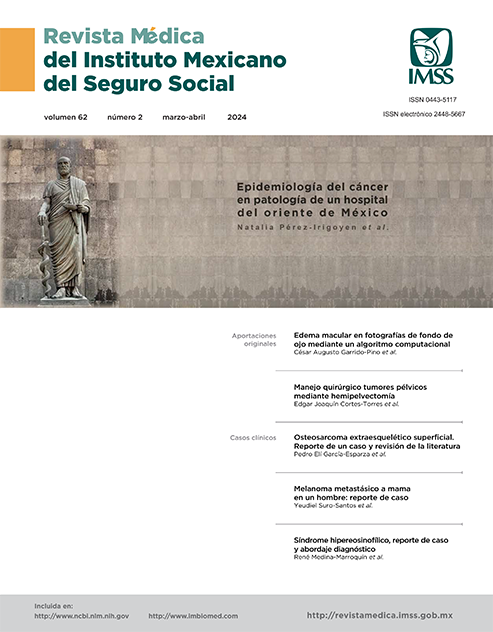Manejo quirúrgico de tumores pélvicos mediante hemipelvectomía
##plugins.themes.themeEleven.article.main##
Palabras clave
Hemipelvectomía, Osteosarcoma, Recurrencia, Mortalidad
Resumen
Introducción: los tumores óseos malignos primarios son raros, pero tienen una alta mortalidad global. El osteosarcoma y el condrosarcoma son los sarcomas óseos más comunes en la pelvis. El manejo quirúrgico de los tumores óseos primarios en la pelvis es desafiante y depende de varios factores. La hemipelvectomía interna con preservación de la extremidad se ha vuelto más popular en comparación con la hemipelvectomía externa.
Objetivo: identificar y describir características del manejo quirúrgico de tumores óseos y tejidos blandos de pelvis mediante hemipelvectomía.
Material y métodos: estudio observacional de casos consecutivos, en el que se identificaron pacientes con tumores óseos y tejidos blandos sometidos a hemipelvectomía en período de enero del 2010 a diciembre del 2020 en el Servicio de Cirugía Oncología, utilizando la escala MSTS (Musculoskeletal Tumor Society).
Resultados: se incluyeron 17 pacientes con tumores pélvicos, 10 (58.8%) sarcomas óseos primarios, 3 (17.6%) sarcomas de tejido blando, 3 (17.6%) tumores óseos benignos, 1 (5.8%) neoplasia de origen hematológico. Seguimiento promedio de 30 ± 14. La complicación quirúrgica más frecuente fue el seroma de herida quirúrgica, presente en 6 pacientes (37.5%).
Conclusiones: se requiere equipo multidisciplinario para individualizar tratamiento con la mejor secuencia de opciones, dando mejoría de resultado oncológico y funcional.
Referencias
Qu Y, Li X, Yan Z, et al. Surgical planning of pelvic tumor using multi-view CNN with relation-context representation learning. Med Image Anal. 2021;69:101954. doi: 10.1016/j.media.2020.101954.
Lee JS, Kelly CM, Bartlett EK. Management of pelvic sarcoma. Eur J Surg Oncol. 2022;48(11):2299-2307. doi: 10.1016/j.ejso.2022.09.011
Benady A, Gortzak Y, Sofer S, et al. Internal Hemipelvectomy for primary bone sarcomas using intraoperative patient specific instruments- the next step in limb salvage concept. BMC Musculoskelet Disord. 2022;23(1):1012. doi: 10.1186/s12891-022-05918-1.
McColl M, Fayad LM, Morris C, et al. Pelvic bone tumor resection: what a radiologist needs to know. Skeletal Radiol. 2020;49(7):1023-1036. doi: 10.1007/s00256-020-03395-y.
Benatto MT, Hussein AM, Gava NF, et al. COMPLICATIONS AND COST ANALYSIS OF HEMIPELVECTOMY FOR THE TREATMENT OF PELVIC TUMORS. Acta Ortop Bras. 2019;27(2):104-107. doi: 10.1590/1413-785220192702206721.
Revuri VR, Moody K, Lewis V, et al. Pain and Analgesia in Children with Cancer after Hemipelvectomy: A Retrospective Analysis. Children (Basel). 2022;9(2):237. doi: 10.3390/children9020237
Ahlawat S, McColl M, Morris CD, et al. Pelvic bone tumor resection: post-operative imaging. Skeletal Radiol. 2021;50(7):1303-1316. doi: 10.1007/s00256-020-03703-6.
Karaca MO, Özbek EA, Özyıldıran M, et al External and internal hemipelvectomy: A retrospective analysis of 68 cases. Jt Dis Relat Surg. 2022;33(1):132-141. doi: 10.52312/jdrs.2022.560.
Mallet J, El Kinani M, Crenn V, et al. French translation and validation of the cross-cultural adaptation of the MSTS functional assessment questionnaire completed after tumor surgery. Orthop Traumatol Surg Res. 2023;109(3):103574. doi: 10.1016/j.otsr.2023.103574.
Brown HK, Schiavone K, Gouin F, et al. Biology of Bone Sarcomas and New Therapeutic Developments. Calcif Tissue Int. 2018;102(2):174-195. doi: 10.1007/s00223-017-0372-2.
Harris MA, Hawkins CJ. Recent and Ongoing Research into Metastatic Osteosarcoma Treatments. Int J Mol Sci. 2022;23(7):3817. doi: 10.3390/ijms23073817.
Weinschenk RC, Wang WL, Lewis VO. Chondrosarcoma. J Am Acad Orthop Surg. 2021;29(13):553-562. doi: 10.5435/JAAOS-D-20-01188.
Shin KH, Rougraff BT, Simon MA. Oncologic outcomes of primary bone sarcomas of the pelvis. Clin Orthop Relat Res. 1994;(304):207-17.
Chow W, Frankel P, Ruel C, et al. Results of a prospective phase 2 study of pazopanib in patients with surgically unresectable or metastatic chondrosarcoma. Cancer. 2020;126(1):105-111.
Hesla AC, Papakonstantinou A, Tsagkozis P. Current Status of Management and Outcome for Patients with Ewing Sarcoma. Cancers (Basel). 2021;13(6):1202. doi: 10.3390/cancers13061202.
Soto DJ. Ewing’s sarcoma in Pediatric pelvis. Literature review. Science and Health Magazine. 2022;6(1): 25-40.
Sacco R, Lalevée M, Pellegrino P, et al. Soft tissue sarcomas of the buttock: A systematic review and meta-analysis. Surg Oncol. 2022;45:101883. doi: 10.1016/j.suronc.2022.101883.
Aksnes LH, Bauer HC, Jebsen NL, et al. Limb-sparing surgery preserves more function than amputation: a Scandinavian sarcoma group study of 118 patients. J Bone Joint Surg Br. 2008;90(6):786-94. doi: 10.1302/0301-620X.90B6.19805.
Renard AJ, Veth RP, Schreuder HW, et al. Function and complications after ablative and limb-salvage therapy in lower extremity sarcoma of bone. J Surg Oncol. 2000;73(4):198-205.
Chao AH, Neimanis SA, Chang DW, et al. Reconstruction After Internal Hemipelvectomy. Annals of Plastic Surgery 2015;74(3): 342-349.
Jamshidi K, Zandrahimi F, Bagherifard A, et al. Type lll internal hemipelvectomy for primary bone tumours with and without allograft reconstruction: a comparison of outcomes. Bone Joint J. 2021;103-B(6):1155-1159. doi: 10.1302/0301-620X.103B6.BJJ-2020-2149.R1.
Mayerson JL, Wooldridge AN, Scharschmidt TJ. Pelvic Resection. Am Acad Orthop Surg. 2014;22(4):214-22.
Kar BK, Kumar-Yadav S, Venishetty N, et al. Internal Hemipelvectomy and Pelvic Reconstruction With Non-Vascularized Fibular Graft for Chondrosarcoma Ilium. Cureus. 2021;13(7):e16292. doi: 10.7759/cureus.16292.
Banskota N, Yang H, Fang X, et al. Comparative study of pelvic sarcoma patients undergoing internal and external hemipelvectomy: A meta-analysis study. Front Surg. 2022;9:988331. doi: 10.3389/fsurg.2022.988331.
Brown JM, Rakoczy K, Hart J, et al. Presenting features and overall survival of chondrosarcoma of the pelvis. Cancer Treat Res Commun. 2022;30:100510. doi: 10.1016/j.ctarc.2022.100510.


